
- •Средняя пространственная частотная характеристика рефлектограммы с одинарным зондирующим импульсом The Average spatial backscattered intensity spectrum of the otdr with single-pulse probe signal
- •Средняя пространственная частотная характеристика рефлектограммы с двухимпульсным зондирующим сигналом с частотным разнесением
- •Метод восстановления сигнала внешнего фазового воздействия на оптическое волокно в рефлектометре с двухимпульсным зондирующим сигналом с частотны мразнесением
- •Экспериментальные средние спектральные характеристики рефлектограмм.
- •Восстановление сигнала внешнего фазового воздействия методом квадратурной демодуляции
- •Заключение
-
Восстановление сигнала внешнего фазового воздействия методом квадратурной демодуляции
Experimental reconstruction of an external impact signal
The experimental setup is shown on figure 4. A high performance RIO Orion™ laser module with a spectral bandwidth of 2 kHz and a 10 dBm power level generates CW light on the wavelength 1550.92 nm. An acousto-optical modulator formes the pair of optical pulses with the shape close to rectangular, time duration of 90 ns and time spacing between pulses equal to 100 ns. Further a JDSU optical phase modulator performes a linear phase modulation of the optical field, shifting the frequency of the first part of double pulse in the negative direction, and the frequency of the second part of double pulse in the positive direction relative to the central laser carrier frequency at 50 MHz.
As a result the carrier frequency differences between the parts of dual-pulse was 100 MHz. The backscattered intensity in the OTDR is detected with the use of synchronous detection scheme and subsequent processing of I and Q – components according to 45 [12].
The external phase perturbation is modeled by means of a PZT transducer with the winding of the optical fiber located at a distance of 1 km from the beginning of the fiber line. On the PZT cylinder was wind approximately 1 m of fiber. The laboratory generator produces an amplitude modulated signal with the carrier frequency 100Hz and modulation frequency 10Hz which is applied to the transducer. The experimental I and Q-components as well as the reconstructed signal are shown in figure 6. As it can be seen, the moderately complex signal of the external action is clearly restored, it proves the applicability of the proposed method.
-
Заключение
Conclusion
In conclusion we proposed a novel approach to construction of a phase-OTDR with dual-pulse probe signal, having different carrier frequencies of the first and the second parts of the dual-pulse.
It is shown that described phase-OTDR has quasi-harmonic backscattered intensity signal with carrier frequency equal to frequency difference of the pulses constituting the dual-pulse. The FWHM of the average OTDR intensity trace spatial power spectrum in the region near the frequency difference in the pulse pair is determined by the shape of the pulses in the pair.
In the case when each pulse in the pulse pair has Gaussian shape the average OTDR spatial power spectrum near the frequency difference is equal to the initial probe pulse power spectrum, in the case when each pulse has rectangular shape this average OTDR spatial power spectrum near the frequency difference is broader than initial probe pulse power spectrum as much as 1.36 times.
The analytical form of the average OTDR spectral characteristics in these limiting cases is determined. Experimental measurement of the average OTDR spectral characteristics is conducted for the cases of singular probe pulses with intensity shapes close to rectangular and close to Gaussian. The measured average spectra are localized near zero frequency in these cases. Theoretical results coincide well with the experimental.
The possibility of the external impact signal reconstruction in proposed OTDR is shown both theoretically and experimentally. Signal demodulation is performed by I/Q demodulation of registered quasi-harmonic backscattered intensity traces.
The advantage of the described scheme in comparison with the previously proposed schemes [1-3] is that it is less complicated for it is not necessary to use optical hybrid, unbalanced interferometer and three independent photodetectors in the receiving end, which makes it more resistant to environmental conditions. Moreover, in contrast to our previous scheme [4], the registration of a single time sample of the external action signal requires only one launch of independent double pulse with afferent carrier frequencies, which in turn raises the maximum frequency of the external signal that could be registered.
The limitations of described scheme consist in relatively high requirements for configuration accuracy of its individual elements. Also, in contrast with phase diversity method [4], the reconstructed signal in the proposed OTDR always contains a phase error, associated with the finite FWHM of the OTDR trace spatial spectrum. This phase error, appearing during detection procedure, could be minimized by enlarging of the frequency spacing between carrier frequencies in the pulse pair or by more optimal selection of the pulse amplitude shape. It should also be noted the possibility of arising nonlinear effects, that lead to frequency chirp of the probe pulses and broadening of average spatial OTDR intensity power spectrum. Broader spatial spectrum will, consequently, lead to a greater phase error when restoring an external impact signal and the necessity to implement more significant frequency diversity in the pulse pair.
References
-
Posey R, Johnson G A, Vohra S T 2000 Strain sensing based on coherent Rayleigh scattering in an optical fibre Electronics Letters 36 1688
-
Masoudi A, Belal M, Newson T P 2013 A distributed optical fibre dynamic strain sensor based on phase-OTDR Measurement Science and Technology 24 1
-
Farhadiroushan M, Parker T R, Shatalin S 2010 Method and apparatus for optical sensing Patent № WO 2010/136810 A2
-
Alekseev A E, Vdovenko V S, Gorshkov B G, Potapov V T, Simikin D E 2014 A phase-sensitive optical time-domain reflectometer with dual-pulse phase modulated probe signal Laser Physics 24 115106
-
Crickmore R I, Hill D J 2013 Phase based sensing Patent № US8537345 B2
-
Alekseev A E, Tezadov Ya A, Potapov V T 2012 Statistical properties of backscattered semiconductor laser radiation with different degrees of coherence Quantum Electronics 42 76
-
Alekseev A E, Tezadov Ya A, Potapov V T 2011 The Influence of the Degree of Coherence of a Semiconductor Laser on the Statistic of the Backscattered Intensity in a Single-Mode Optical Fiber Journal of Communications Technology and Electronics 56 1522
-
Gysel P, Staubli R K Statistical Properties of Rayleigh Backscattering in Single-Mode Fibers Journal of Lightwave Technology 1990 8 561
-
Goodman J W 2007 Speckle Phenomena in Optics: Theory and Applications (Englewood, Colo.: Roberts & Co)
-
Goodman J W 1985 Statistical Optics (New York: John Wiley & Sons)
-
Mandel L, Wolf E 1995 Optical Coherence and Quantum Optics (Cambridge UK: Cambridge University Press)
-
Etten Wim van 2005 Introduction to Random Signals and Noise (Chichester, West Sussex, England: John Wiley & Sons Ltd.)
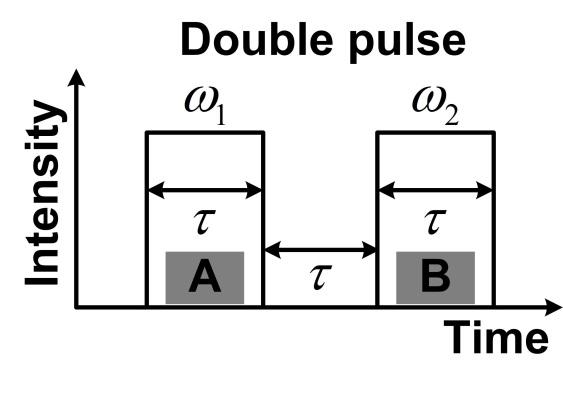
Figure
1. Schematic representation of the dual-pulse probe signal with
different carrier frequencies of its first
 and the second
and the second
 parts.
parts.
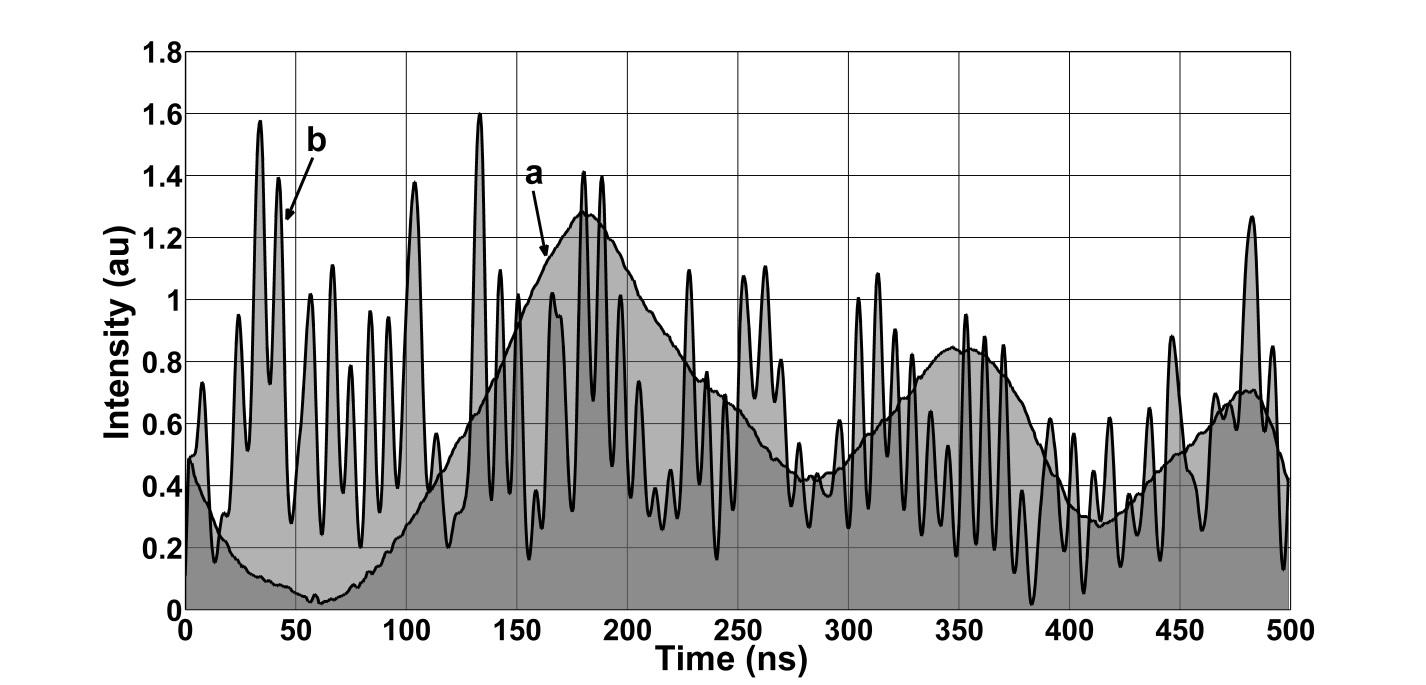
Figure 2. Experimental OTDR intensity traces, obtained with the use of dual-pulse probe signal without frequency diversity of carrier frequencies a) and with frequency diversity of carrier frequencies b), the oscillation character of the trace is observed.

Figure 3. Schematic representation of scattering regions of the first and the second pulses, constituting the pulse pair. The external impact is applied at the point between two scattering regions.
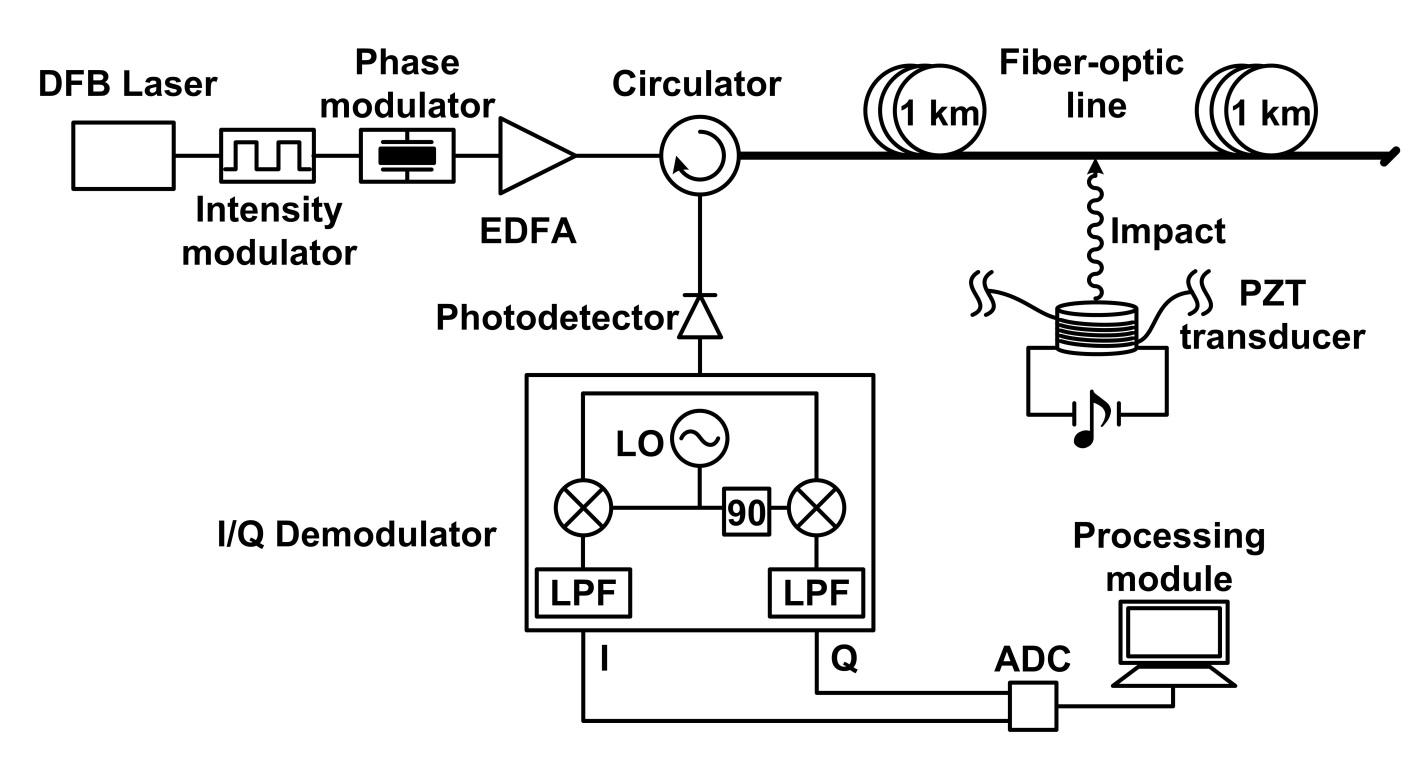
Figure 4. Phase-OTDR with dual-pulse diversity frequency probe signal, I/Q demodulator is also shown schematically.
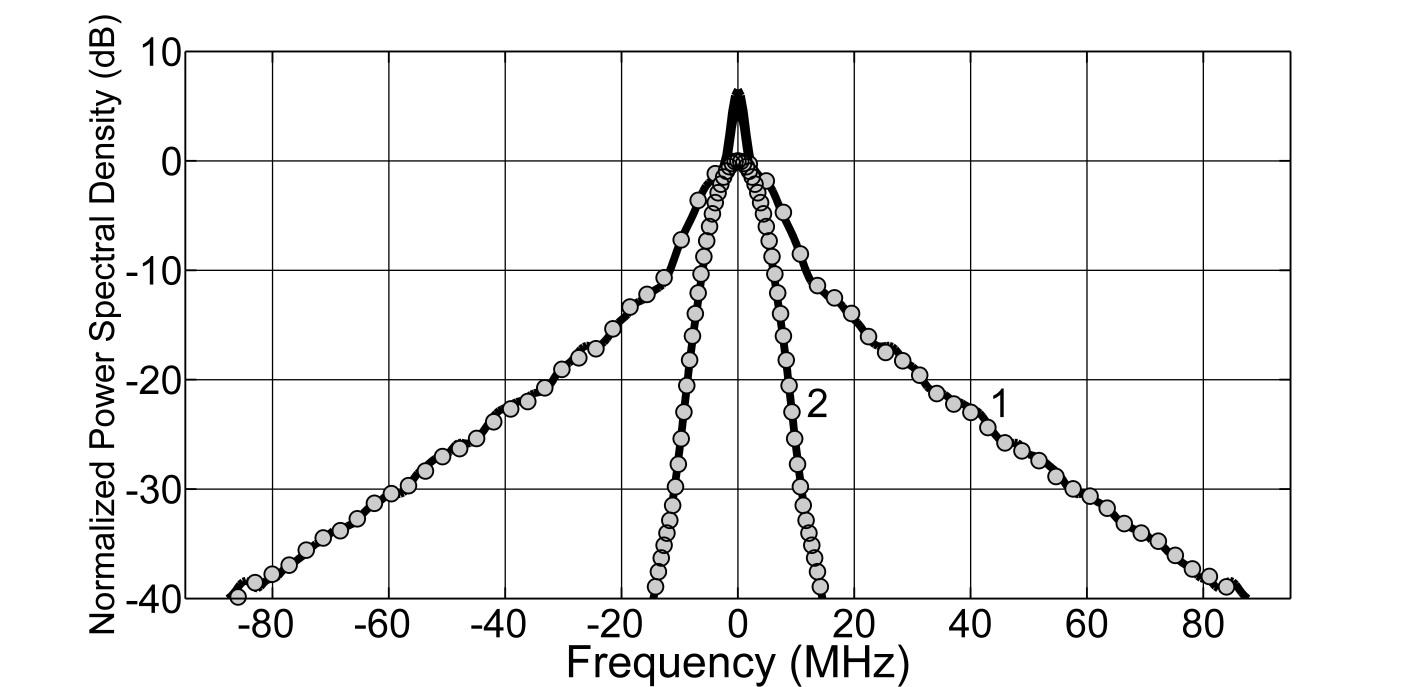
Figure 5. Normalized average spatial intensity power spectra of OTDR with singular probe pulse, which has amplitude shape close to rectangular:1 and close to Gaussian: 2. Experimental curves-continuous lines, theoretical curves – circles.
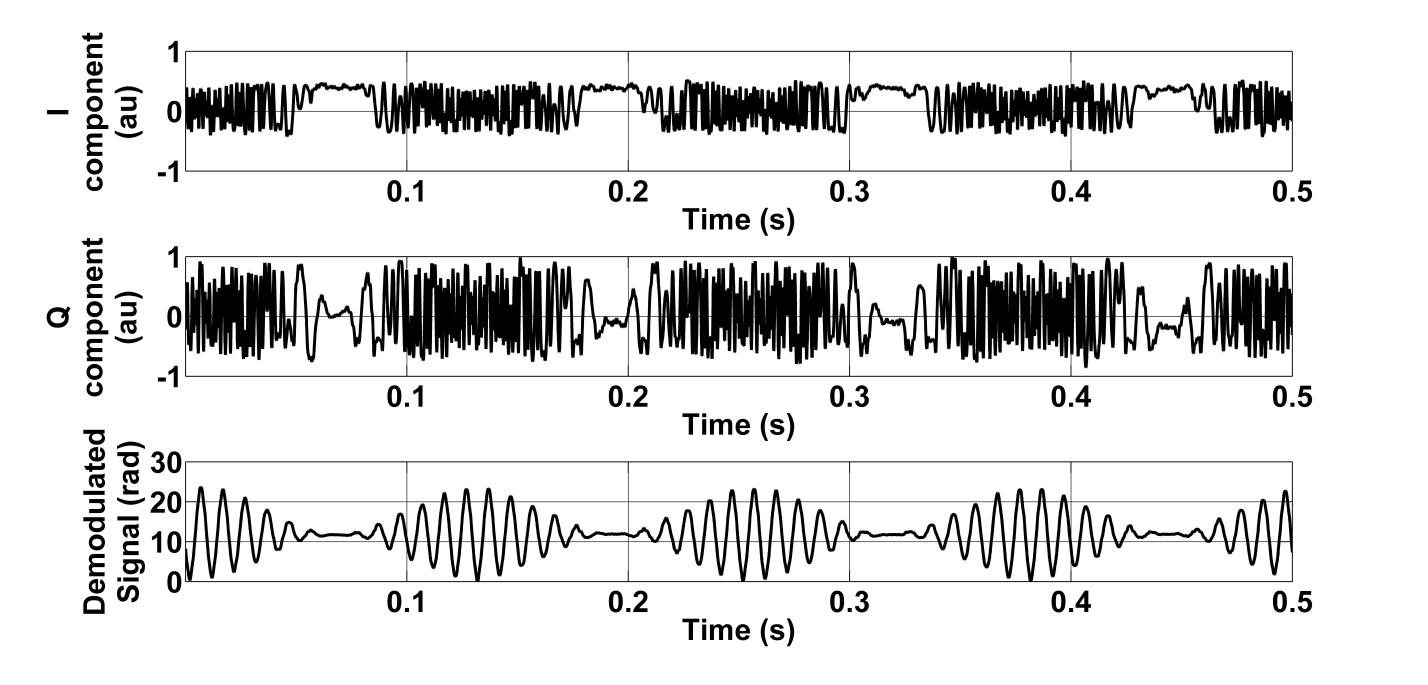
Figure 6. Experimental time dependence of in-phase, I- component and quadrature Q- component, when amplitude modulated signal with carrier frequency 100 Hz and modulation frequency 10 Hz is applied to the transducer. The external impact signal, which is restored with the use of I/Q demodulation, is shown below.
